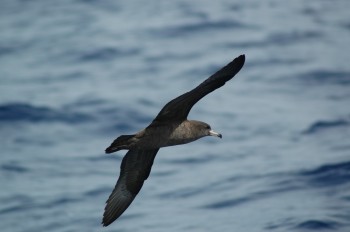Alex Bond (Department of Biology, University of Saskatchewan, Saskatoon, Canada) and Jennifer Lavers write in the journal Global Change Biology on evidence that the Flesh-footed Shearwaters Puffinus carneipes has changed its diet historically from 1936.
The paper’s abstract follows:
“Changes in the world's oceans have altered nutrient flow, and affected the viability of predator populations when prey species become unavailable. These changes are integrated into the tissues of apex predators over space and time and can be quantified using stable isotopes in the inert feathers of historical and contemporary avian specimens. We measuredδ13C andδ15N values in Flesh-footed Shearwaters (Puffinus carneipes) from Western and South Australia from 1936-2011. The Flesh-footed Shearwaters more than doubled their trophic niche (from 3.91 ± 1.37 ‰2to 10.00 ± 1.79 ‰2), and dropped an entire trophic level in 75 years (predictedδ15N decreased from +16.9 ‰ to +13.5 ‰, andδ13C from –16.9 ‰ to –17.9 ‰) – the largest change inδ15N yet reported in any marine bird, suggesting a relatively rapid shift in the composition of the Indian Ocean food web, or changes in baselineδ13C andδ15N values. A stronger El Niño-Southern Oscillation results in a weaker Leeuwin Current in Western Australia, and decreased Flesh-footed Shearwaterδ13C andδ15N. Current climate forecasts predict this trend to continue, leading to increased oceanic ‘tropicalisation’ and potentially competition between Flesh-footed Shearwaters and more tropical sympatric species with expanding ranges. Flesh-footed Shearwater populations are declining, and current conservation measures aimed primarily at bycatch mitigation are not restoring populations. Widespread shifts in foraging, as shown here, may explain some of the reported decline. An improved understanding and ability to mitigate the impacts of global climactic changes is therefore critical to the long-term sustainability of this declining species.”

Flesh-footed Shearwater, photograph by Tim Reid
With thanks to Jenn Lavers for information.
Reference:
Bond, A.L. & Lavers, J.L. 2014. Climate change alters the trophic niche of a declining apex marine predator. Global Change Biology DOI: 10.1111/gcb.12554.
John Cooper, ACAP Information Officer, 27 March 2014

 English
English  Français
Français  Español
Español